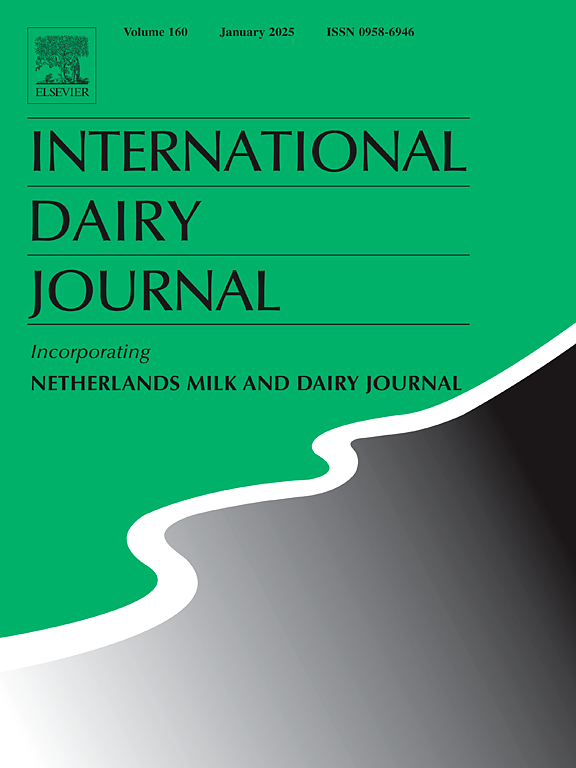Separation of whey protein-pectin complexes and unbound pectin in technical scale: A feasibility study
IF 3.4
3区 农林科学
Q2 FOOD SCIENCE & TECHNOLOGY
引用次数: 0
Abstract
Whey protein-pectin complexes (WPPC) have the potential to be utilized as a fat replacer. However, following the formation of the whey protein-pectin complexes via thermomechanical treatment, a proportion of pectin remains unbound in the surrounding phase, exhibiting the potential to modify the textural attributes of fat-reduced products and overlapping with the effect of the actual WPPC in the dispersion. Therefore, the separation of unbound pectin from the WPPC was investigated. The addition of 1 mol L−1 CaCl2 and subsequent centrifugation (4000×g, 10 min) yielded high protein concentrations of approximately 80 % in laboratory scale, while approximately 60 % of the pectin was separated. However, the separation process is only suitable for laboratory scale applications and could not be successfully upscaled to a continuous decanter centrifuge. The microfiltration with diafiltration (1.4 μm, 50 °C, 0.1 MPa) proved effective, yielding approximately 82 % protein in the permeate and separating approximately 80 % of the pectin. The pectin-rich dispersion could be successfully recycled, for a new batch of WPPC even improving the resulting complex size range. The separation of unbound pectin from the WPPC allows for the investigation of the effect of the actual WPPC during product application.
乳清蛋白-果胶配合物与未结合果胶技术分离的可行性研究
乳清蛋白-果胶复合物(WPPC)具有作为脂肪替代品的潜力。然而,在通过热机械处理形成乳清蛋白-果胶复合物之后,一定比例的果胶仍未结合在周围相中,显示出改变脂肪还原产物的结构属性的潜力,并与实际WPPC在分散中的作用重叠。因此,研究了从WPPC中分离未结合果胶的方法。加入1 mol L−1 CaCl2并随后离心(4000×g, 10分钟),在实验室规模下,产生约80%的高蛋白质浓度,而约60%的果胶被分离。然而,分离过程只适用于实验室规模的应用,不能成功地升级到连续卧螺离心机。微滤(1.4 μm, 50°C, 0.1 MPa)证明是有效的,在渗透液中产生约82%的蛋白质,分离约80%的果胶。富含果胶的分散体可以成功回收,用于新一批的WPPC,甚至可以提高所得到的复合尺寸范围。将未结合的果胶从WPPC中分离出来,可以在产品应用过程中研究实际WPPC的效果。
本文章由计算机程序翻译,如有差异,请以英文原文为准。
求助全文
约1分钟内获得全文
求助全文
来源期刊

International Dairy Journal
工程技术-食品科技
CiteScore
6.50
自引率
9.70%
发文量
200
审稿时长
49 days
期刊介绍:
The International Dairy Journal publishes significant advancements in dairy science and technology in the form of research articles and critical reviews that are of relevance to the broader international dairy community. Within this scope, research on the science and technology of milk and dairy products and the nutritional and health aspects of dairy foods are included; the journal pays particular attention to applied research and its interface with the dairy industry.
The journal''s coverage includes the following, where directly applicable to dairy science and technology:
• Chemistry and physico-chemical properties of milk constituents
• Microbiology, food safety, enzymology, biotechnology
• Processing and engineering
• Emulsion science, food structure, and texture
• Raw material quality and effect on relevant products
• Flavour and off-flavour development
• Technological functionality and applications of dairy ingredients
• Sensory and consumer sciences
• Nutrition and substantiation of human health implications of milk components or dairy products
International Dairy Journal does not publish papers related to milk production, animal health and other aspects of on-farm milk production unless there is a clear relationship to dairy technology, human health or final product quality.
 求助内容:
求助内容: 应助结果提醒方式:
应助结果提醒方式:


